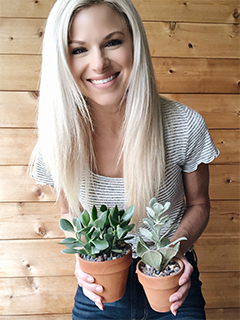
For those of us who were stuck at home this past year, the company of plants has been boundlessly beneficial. Whether you aspire to an indoor jungle or just to keep something green alive for more than two weeks, Dana Carpenter of Fancy Plants Club shares all you need to know to become a confident plant parent.
Don't Give Up
You may have labeled yourself with a black thumb after helplessly watching a succession of plants wither, but Carpenter is convinced you should try again. “Maybe you started out with an unhealthy plant that had been sitting in a dark warehouse,” she says. Maybe you used a one-size-fits-all approach on plants with varying needs. Try again because anyone can raise plants!
Get Acquainted
Before you bring a plant home, suss out the spot where you'd like to put it so you can pick a plant that will like being there. “How much sunlight will it get? How humid is the space?” Carpenter asks. “Take the time to read about the plant instead of impulse buying.”
Some plants need very little light, some need frequent watering and some like to stay very dry. The better you know each of your plants and their preferences, the more successful you'll be.
Defend Against Pests
Especially if you're adding to your plant collection, be careful about inviting unwelcome guests into the fold. “I like to set a new plant aside for a week or two after bringing it home and check that no pests appear,” says Carpenter, who quarantines new plants in a separate room. Check for the quick-spreading fungus gnat and other baddies in the nursery before buying. Even the best plant shops can unwittingly give you pests.
Visit Often
One of the best things about having plants around the house is spending time with them! They need you to gently paw through their leaves checking for signs of pests, dead leaves and crowding. “Like trimming the dead ends of hair,” Carpenter says, “pinching away yellow or brown leaves keeps plants healthy and fresh-looking.” Plants grow faster and fuller with straggling leaves trimmed away, and your connection with your plants grows, too.
Don't Overwater
Like a loving grandmother foisting meatballs on an overstuffed grandchild, we often fall into the deadly trap of overwatering our plants. “Don't water based on a schedule,” Carpenter warns. You're going to have to get your hands dirty. Poke a finger an inch or two into the soil and check if it's dry. That's when it's time to water. Carpenter recommends using room temperature water and reminds us, “Less is more!”
Plant Food
In spring and summer, plants grow faster, requiring more water and even fertilizer to spur their new sprouts. “A fertilizer replaces nutrients in the soil that have been used by the plant over time,” says Carpenter, who's a fan of Miracle-Gro. Following the package directions, an infusion of plant food monthly or even every two weeks in the growing seasons will keep your plants thriving.
Repot the Root-Bound
Some plants are slow growing and will be happy in one pot for years with a little soil replenishment. Others grow actively and can outgrow their pots every 12 to 18 months. A quick way to check if your plant is getting crowded is to see if roots are making their way through the drainage holes in the bottom of the pot.
Early spring, when plants are entering their active growing season, is a good time to repot. Aim for a new pot that's around two to four inches larger in diameter, with drainage holes to keep roots from getting soggy. Keeping old nursery pots is useful as they can become hand-me-downs for up-and-coming houseplants, and their plain exteriors disappear inside decorative planters.
A Crop of Cuttings
Another joy of cultivating plants is propagation, not just to multiply your own collection, but because you can gift and swap baby plants with your friends. You'll have to research the methods that work with each type of plant, but some advice is universal: Plants do best with propagation in the spring and summer, and you can prepare your healthiest specimens with deliberate fertilization in advance and watering a day or so before. “Take more cuttings than you need,” says Carpenter, who loves propagating succulents. “Not all of them will grow successfully, and it doesn't mean you're doing anything wrong.” Use the proper tools—like a sharp knife to make clean cuts. Know your plant and you can proudly watch new babies take root and flourish.
Ready to Get Started?
Here are Dana's Plant Recommendations for Beginners:
Pothos: Dramatic trailing vines, forgiving, easy to propagate
Snake plant: Tolerant of low light, almost invincible, exotic beauty
Spider plant: Great for hanging baskets, propagates itself with “spiderettes,” hard to kill

The Expert:
Dana Carpenter
Founder, Fancy Plants Club
















